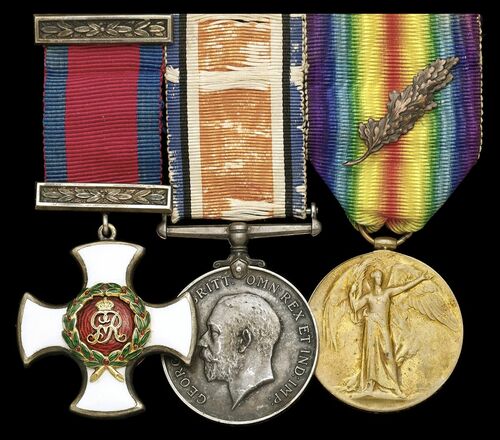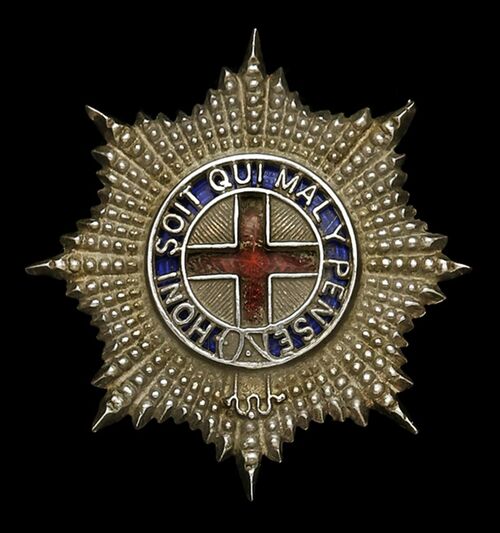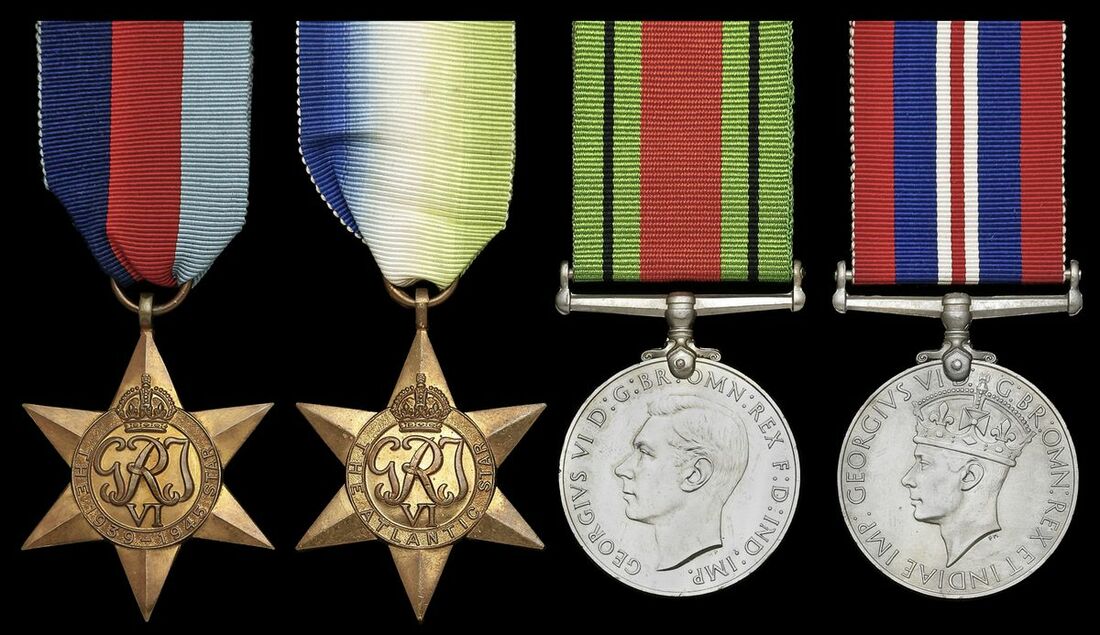Auction: 23003 - Orders, Decorations and Medals
Lot: 258
A very fine Subalterns 1918 D.S.O. group of seven to Lieutenant R. H. S. Fitzroy De Vere Somerset, Coldstream Guards later Royal Air Force and Royal Naval Volunteer Reserve
Distinguished Service Order, G.V.R., silver-gilt and enamel; British War and Victory Medals, with M.I.D. oak leaves (Lieut R. H. F. De V. S. Somerset.); 1939-1945 Star; Atlantic Star; Defence and War Medals 1939-45, the first three mounted as worn, very fine (7)
D.S.O. London Gazette 18 February 1918:
'For conspicuous gallantry and devotion to duty. He led his men with great dash and determination in an attack, and, having captured the final objective, he organised and led an attack on a strong point, which he captured. He was driven out by heavy shell fire, but once led another attack and regained and held the position and captured a field gun. He set a magnificent example of courage, initiative, and leadership.'
M.I.D. London Gazette 23 May 1918.
Henry Robert Somers Fitzroy De Vere Somerset was born on 3 March 1898, the son of Henry Charles Somers Augustus Somerset and his first wife, Lady Katherine de Vere Beauclerk. At the time of his birth Somerset was the Heir-Presumptive to title of Duke of Beaufort, through his great-grandfather, the 8th Duke of Beaufort. Educated at Eton, he then went to Sandhurst for terms between June 1913-September 1915. Promoted Lieutenant on 25 October 1915, Somerset served on the Western Front from 30 March 1917. He was soon to be thrown into the Battle of Cambrai.
The Battle of Bourlon Wood - 27 November 1917
The Battalion War Diary takes up the story:
'The Battalion moved forward to take up its position in the front line at 3.30am and was in position a 5a.m. On our left in BOURLON WOOD were the Irish Guards, on our right the 3rd Battalion Grenadier Guards with the 1st Scots Guards on their right The Battalion front extended from railway to North Edge of FONTAINE to East edge of BOURLON WOOD. Our order was No 4 Company on the left touching the Irish Guards, No 2 Company in the centre and No 3 Company on the right with 3 Platoons of No 1 Company supporting No 3 Company and one Platoon of No 1 Company supporting No 4 Company. The attack commenced at 6.20 a.m. on a very cold morning while it was still dark. Throughout the whole action there was the most severe fighting. The Battalion however reached its first objective and after a pause for reorganization the two Companies on the right who alone had a second objective, pushed on and won this line too. All companies had by this time been through fighting of the severest nature and had suffered very heavy losses. The Germans had however suffered still greater losses, losing some 600 prisoners to the Battalion, and leaving a very large number of dead on the field. Still larger numbers of Germans were brought up and the Battalion was not in a position in its weakened condition to hold its very extended line on the final objective. No 4 Company, in particular, had suffered the heaviest losses as it had met with the strongest opposition and was also enfiladed continuously from BOULON WOOD on which its left rested. A retirement was inevitable and the Battalion fell back in good order and in its own time to the jumping off point in the Quarry near BOURLON WOOD. There reorganization took place and the Battalion consisting of 6 Officers and 200 men prepared to the Quarry. Touch was effected with the 3rd Grenadiers on the right and the 4th Grenadiers, who had been sent up in support, on the left. The Quarry had been very heavily shelled all the morning, but on the remnants of the Battalion falling back into it, the enemy very considerably ceased to shell it, though he continued to shell BOURLON WOOD and the main CAMBRAI road. During the afternoon some fifty men came in, who had been cut off or lost before. At 9p.m. after nine hours in the Quarry, the Battalion was relieved by the 1st Battalion Grenadier Guards, and went out to FLESQUIERES where Officers and men were most hospitably taken in by the 3rd Guards Brigade Headquarters. During the Action Lieut Samuelson was killed and Lieut Clark mortally wounded. Lieut Newland, 2nd Lieut Peake, 2nd Lieut Perry, 2nd Lieut Lockwood, Lieut Somerset, Lieut Corbett, Lieut Porter and 2nd Lieut Nickerson were wounded. Also Lieut Lord H. Kennedy was wounded at Brigade Headquarters. Some 310 Other Ranks were killed and wounded including Sgt Eeles, Sgt Dutton, Sgt Duffin killed.'
Somerset returned to the United Kingdom and was based at Reading from 30 March 1918 where he commenced training with the Central Flying School, spending time at Netheravon and Cranwell, graduating on 11 August 1918 with the rank of Lieutenant. Reliquishing his temporary Royal Air Force Commission on return to Army duty on 20 November 1919, Somerset retired on 27 August 1920.
A qualified Fixed Wing Pilot Somerset became an Autogiro Pilot on 15 November 1933 gaining his certificate on a Genet Major.
Returned to the fold upon the outbreak of the Second World War, he soon resigned his commission in the Army on 21 October 1939 in order to join the Royal Naval Volunteer Reserve on 16 November 1940 as a Temporary Lieutenant. Promoted Lieutenant the same day he was posted to the destroyer Montgomery. This former American vessel was commissioned under the White Ensign on 23 October 1940, under Commander. H.F. Nash, (retired).
After fitting out and familiarization the destroyer departed Canadian waters on 1 November, bound for Britain. En-route, Montgomery and the other of her sister ships in company swept through the scene of the one-sided naval engagement between the armed merchant cruiser HMS Jervis Bay and the German 'pocket battleship' Admiral Scheer. This action occurred on 5 November when the German warship attacked a convoy escorted by the erstwhile merchant steamship. Jervis Bay had gallantly interspersed herself between the raider and the convoy, allowing the latter to escape while being herself smashed to pieces and sunk. Montgomery found nothing, however, and after searching briefly for the German warship arrived at Belfast, Northern Ireland on 11 November.
Shifting to Plymouth, a week later, Montgomery was allocated to the Western Approaches command and based at Liverpool. During the course of one of her early patrols, she rescued 39 survivors from the torpedoed motor tanker Scottish Standard which had been torpedoed and sunk by U-96 on 21 February 1941. Disembarking the rescued mariners three days later, Montgomery resumed her Western Approaches patrols soon thereafter.
The flush-decker underwent repairs at Barrow, Laneashire from April to September and was later assigned to the 4th Escort Group. Based now at Greenock, Scotland, she operated between the British Isles and Canadian ports through the end of 1941.
Somerset married Bettine, the daughter of the late Hon. Mrs Sopwith and late Major C. E. Malcolm, they had three children one of whom was Lieutenant John Alexander Somerset who was killed in action on 15 April 1945, whilst serving with the Coldstream Guards. The elder Somerset became a noted yachtsman in both British and American waters and as well as and being a boat builder was also a member of the Royal Ocean Racing club. He retired out to Casa Coramandel, Puerto Andraitx, Mallorca, Spain following the war. Somerset was lost along with his yacht Trenchemer off Rhodes, Greece, on 27 February 1965. He is buried in St.Michael's & All Angels Churchyard, Little Badminton, South Gloucestershire. At the time of his death Somerset was Heir Presumptive to the 10th Duke of Beaufort, the title eventually passed to a second cousin; sold together with a Coldstream Guards cap badge.
For his miniature dress medals, please see Lot 331.
Subject to 20% VAT on Buyer’s Premium. For more information please view Terms and Conditions for Buyers.
Sold for
£2,000
Starting price
£1600









